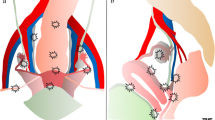Abstract
Objective
To study the sensitivity of MRI performed utilising vaginal and rectal opacification with ultrasound gel in the detection of deep pelvic endometriosis.
Material and methods
This was a prospective monocentric study. All patients evaluated by the gynaecologist for pelvic pain, endometriosis or infertility were included. Axial and sagittal T2-weighted images were performed both with and without vaginal and rectal opacification with ultrasound gel. Three radiologists, all blinded, interpreted the images with a minimum of 15 days between the two readings. MRI performance with and without vaginal and rectal opacification was evaluated by calculating sensitivity, specificity and both positive and negative predictive values.
Results
Seventy-eight patients were included. Among these, 31 patients had deep pelvic endometriosis of which 24 were confirmed by laparoscopy. Seventy-six locations of deep pelvic endometriosis were discovered on MRI. For the three reviewers there was a significant improvement in sensitivity between pre- and post-contrast MRI (p < 0.0002).
Conclusion
Opacification of the vagina and rectum significantly improved the sensitivity of MRI for the detection of deep pelvic endometriosis by expanding the vagina and rectum, thus allowing better delineation of the pelvic organs. This was especially apparent for lesions localised to the vagina and rectovaginal septum.




Similar content being viewed by others
References
Koninckx PR, Meuleman C, Demeyere S, Lesaffre E, Cornillie FJ (1991) Suggestive evidence that pelvic endometriosis is a progressive disease, whereas deeply infiltrating endometriosis is associated with pelvic pain. Fertil Steril 55:759–765
Chapron C, Fauconnier A, Vieira M et al (2003) Anatomical distribution of deeply infiltrating endometriosis: surgical implications and proposition for a classification. Hum Reprod 18:157–161
Kataoka ML, Togashi K, Yamaoka T et al (2005) Posterior cul-de-sac obliteration associated with endometriosis: MR imaging evaluation. Radiology 234:815–823
Ford J, English J, Miles WA, Giannopoulos T (2004) Pain, quality of life and complications following the radical resection of rectovaginal endometriosis. BJOG 111:353–356
Hollett-Caines J, Vilos GA, Penava DA (2003) Laparoscopic mobilization of the rectosigmoid and excision of the obliterated cul-de-sac. J Am Assoc Gynecol Laparosc 10:190–194
Abbott JA, Hawe J, Clayton RD, Garry R (2003) The effects and effectiveness of laparoscopic excision of endometriosis: a prospective study with 2–5 year follow-up. Hum Reprod 18:1922–1927
Redwine DB, Wright JT (2001) Laparoscopic treatment of complete obliteration of the cul-de-sac associated with endometriosis: long-term follow-up of en bloc resection. Fertil Steril 76:358–365
Chopin N, Vieira M, Borghese B et al (2005) Operative management of deeply infiltrating endometriosis: results on pelvic pain symptoms according to a surgical classification. J Minim Invasive Gynecol 12:106–112
Zanardi R, Del Frate C, Zuiani C, Bazzocchi M (2003) Staging of pelvic endometriosis based on MRI findings versus laparoscopic classification according to the American Fertility Society. Abdom Imaging 28:733–742
Roy C, Balzan C, Thoma V, Sauer B, Wattiez A, Leroy J (2009) Efficiency of MR imaging to orientate surgical treatment of posterior deep pelvic endometriosis. Abdom Imaging 34:251–259
Kinkel K, Frei KA, Balleyguier C, Chapron C (2006) Diagnosis of endometriosis with imaging: a review. Eur Radiol 16:285–298
Del Frate C, Girometti R, Pittino M, Del Frate G, Bazzocchi M, Zuiani C (2006) Deep retroperitoneal pelvic endometriosis: MR imaging appearance with laparoscopic correlation. Radiographics 26:1705–1718
Bazot M, Darai E, Hourani R et al (2004) Deep pelvic endometriosis: MR imaging for diagnosis and prediction of extension of disease. Radiology 232:379–389
Jarlot C, Anglade E, Paillocher N, Moreau D, Catala L, Aubé C (2008) MR imaging features of deep pelvic endometriosis: correlation with laparoscopy. J Radiol 89:1745–1754
Ha HK, Lim YT, Kim HS, Suh TS, Song HH, Kim SJ (1994) Diagnosis of pelvic endometriosis: fat-suppressed T1-weighted vs conventional MR images. Am J Roentgenol 163:127–131
Mondot L, Novellas S, Senni M et al (2006) Pelvic prolapse: static and dynamic MRI. Abdom Imaging 32:775–783
Akata D, Kerimoglu U, Hazirolan T et al (2005) Efficacy of transvaginal contrast-enhanced MRI in the early staging of cervical carcinoma. Eur Radiol 15:1727–1733
Van Hoe L, Vanbeckevoort D, Oyen R, Itzlinger U, Vergote I (1999) Cervical carcinoma: optimized local staging with intravaginal contrast-enhanced MR imaging—preliminary results. Radiology 213:608–611
Urban M, Rosen HR, Hölbling N et al (2000) MR imaging for the preoperative planning of sphincter-saving surgery for tumors of the lower third of the rectum: use of intravenous and endorectal contrast materials. Radiology 214:503–508
van Leeuwen E (1990) Between scientific application and therapy: the ethical consideration. Dev Biol Stand 71:161–170
Brown MA, Mattrey RF, Stamato S (2005) MRI of the female pelvis using vaginal gel. AJR 185:1221–1227
Takeuchi H, Kuwatsuru R, Kitade M et al (2005) A novel technique using magnetic resonance imaging jelly for evaluation of rectovaginal endometriosis. Fertil Steril 83:442–447
Kikuchi I, Takeuchi H, Kuwatsuru R et al (2009) Diagnosis of complete cul-de-sac obliteration (CCDSO) by the MRI jelly method. J Magn Reson Imaging 29:365–370
Bazot M, Nassar J, Daraï E et al (2005) Value of sonography and MR imaging for the evaluation of deep pelvic endometriosis. J Radiol 86:461–467
Abrao MS, Gonçalves MO, Dias JA Jr, Podgaec S, Chamie LP, Blasbalg R (2007) Comparison between clinical examination, transvaginal sonography and magnetic resonance imaging for the diagnosis of deep endometriosis. Hum Reprod 22:3092–3097
Chapron C, Dubuisson JB, Pansini V et al (2002) Routine clinical examination is not sufficient for diagnosing and locating deeply infiltrating endometriosis. J Am Assoc Gynecol Laparosc 9:115–119
Bazot M, Thomassin I, Hourani R, Cortez A, Darai E (2004) Diagnostic accuracy of transvaginal sonography for deep pelvic endometriosis. Ultrasound Obstet Gynecol 24:180–185
Author information
Authors and Affiliations
Corresponding author
Rights and permissions
About this article
Cite this article
Chassang, M., Novellas, S., Bloch-Marcotte, C. et al. Utility of vaginal and rectal contrast medium in MRI for the detection of deep pelvic endometriosis. Eur Radiol 20, 1003–1010 (2010). https://doi.org/10.1007/s00330-009-1627-8
Received:
Revised:
Accepted:
Published:
Issue Date:
DOI: https://doi.org/10.1007/s00330-009-1627-8




